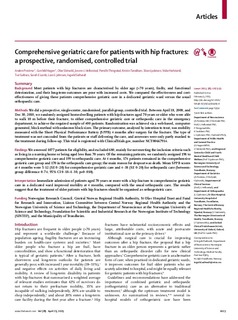| dc.contributor.author | Prestmo, A. | |
| dc.contributor.author | Hagen, G. | |
| dc.contributor.author | Sletvold, O. | |
| dc.contributor.author | Helbostad, J.L. | |
| dc.contributor.author | Thingstad, P. | |
| dc.contributor.author | Taraldsen, K. | |
| dc.contributor.author | Saltvedt, I. | |
| dc.date.accessioned | 2018-02-28T09:06:59Z | |
| dc.date.available | 2018-02-28T09:06:59Z | |
| dc.date.issued | 2015 | |
| dc.identifier.citation | Prestmo, A., Hagen, G., Sletvold, O., Helbostad, J. L., Thingstad, P., Taraldsen, K., . . . Saltvedt, I. (2015). Comprehensive geriatric care for patients with hip fractures: a prospective, randomised, controlled trial. The Lancet, 385(9978), 1623–1633. | nb_NO |
| dc.identifier.uri | http://hdl.handle.net/11250/2487545 | |
| dc.description.abstract | Background: Most patients with hip fractures are characterised by older age (>70 years), frailty, and functional deterioration, and their long-term outcomes are poor with increased costs. We compared the effectiveness and cost-effectiveness of giving these patients comprehensive geriatric care in a dedicated geriatric ward versus the usual orthopaedic care.
Methods: We did a prospective, single-centre, randomised, parallel-group, controlled trial. Between April 18, 2008, and Dec 30, 2010, we randomly assigned home-dwelling patients with hip-fractures aged 70 years or older who were able to walk 10 m before their fracture, to either comprehensive geriatric care or orthopaedic care in the emergency department, to achieve the required sample of 400 patients. Randomisation was achieved via a web-based, computer-generated, block method with unknown block sizes. The primary outcome, analysed by intention to treat, was mobility measured with the Short Physical Performance Battery (SPPB) 4 months after surgery for the fracture. The type of treatment was not concealed from the patients or staff delivering the care, and assessors were only partly masked to the treatment during follow-up. This trial is registered with ClinicalTrials.gov, number NCT00667914.
Findings: We assessed 1077 patients for eligibility, and excluded 680, mainly for not meeting the inclusion criteria such as living in a nursing home or being aged less than 70 years. Of the remaining patients, we randomly assigned 198 to comprehensive geriatric care and 199 to orthopaedic care. At 4 months, 174 patients remained in the comprehensive geriatric care group and 170 in the orthopaedic care group; the main reason for dropout was death. Mean SPPB scores at 4 months were 5·12 (SE 0·20) for comprehensive geriatric care and 4·38 (SE 0·20) for orthopaedic care (between-group difference 0·74, 95% CI 0·18–1·30, p=0·010).
Interpretation: Immediate admission of patients aged 70 years or more with a hip fracture to comprehensive geriatric care in a dedicated ward improved mobility at 4 months, compared with the usual orthopaedic care. The results suggest that the treatment of older patients with hip fractures should be organised as orthogeriatric care. | nb_NO |
| dc.publisher | The Lancet | nb_NO |
| dc.subject | comprehensive geriatric care | nb_NO |
| dc.subject | hip fractures | nb_NO |
| dc.subject | orthogeriatric care | nb_NO |
| dc.subject | elderly | nb_NO |
| dc.subject | pasientforløp | nb_NO |
| dc.title | Comprehensive geriatric care for patients with hip fractures: a prospective, randomised, controlled trial | nb_NO |
| dc.type | Journal article | nb_NO |
| dc.source.pagenumber | 1623–1633 | nb_NO |
| dc.source.volume | 385 | nb_NO |
| dc.source.journal | The Lancet | nb_NO |
| dc.source.issue | 9978 | nb_NO |
| dc.identifier.doi | 10.1016/S0140-6736(14)62409-0 | |
| dc.description.localcode | måsjekkes | |
